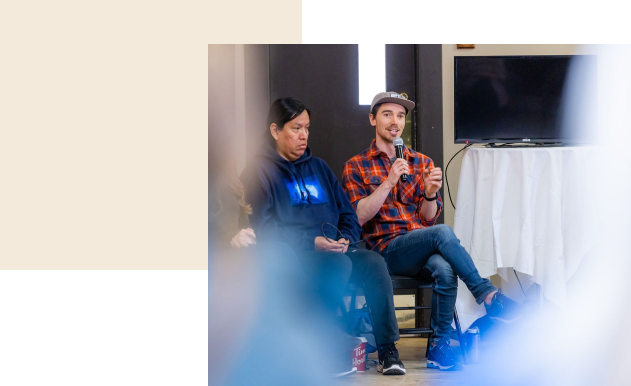Approach
Moving Mountains: A Civil Society Driven Approach
The community change that civil society sought to advance through the Moving Mountains Initiative consisted of a series of complex problems that required a balance of sometimes opposing views and interests. The intersectional research approach adopted by the Initiative team combined core aspects of Human Centered Design, Two Eyed Seeing and Co-creation. The intersectional research approach selected for the initiative amplified equity centered community research and thought leadership, applied an equity centered research lens to processes, and utilized a community centered knowledge framework to guide data collection and reporting processes.

2
Empowering a Connected Community of Care

Phase 1
The Moving Mountains Initiative started with listening. In Fall 2021, we began Phase 1 with eight months of intensive civil society engagement, relationship building, and listening. Initiative Co-Leads Daryl Kootenay and Jeanie Macpherson shared their perspectives on the importance of starting in this way, that is, with listening and through empowering changemakers. Read more about it here, in conversation with Banff Canmore Community Foundation.
Phase 2
In Phase 2, we conducted an analysis of what we heard, and (in)validated our findings with civil society. We identified ‘problem’ and ‘opportunity’ spaces, attributing data points to those of highest saturation, and organizing them into clusters. The clusters were grouped thematically and given names, such as “Environmental and Cultural Learning’, and so on. We grouped the findings in a common and accessible language, and were purposeful in our work to honor the intention and story from which the data emerged. We went back to civil society to help us validate and invalidate what was shared, and how we grouped them. That is, we checked back with the community to ensure what we heard was represented accurately, with integrity, honoring a shared meaning and language. Checking back with the community helped us to deepen and shape a shared understanding within civil society, and also identified challenging, inaccurate or conflicting language and/or intentions.
Phase 3
In Phase 3, we empowered and activated 5 Learn and Try Groups. Group participants ranged in numbers, from groups with 5 members to groups with 21 members. The groups were convened in alignment with the thematic ‘opportunity spaces’ civil society had collectively named in earlier phases of the initiative. These included:
Mental Health and Wellness
Housing, Affordability and Livability
Indigenous and Local Economy
Cultural and Environmental Learning
Reconcili-ACTION
The groups accepted the creative, collaborative challenge to “Learn and Try’ together - that is, to ‘learn’ together about the challenge and opportunity spaces as revealed earlier in the initiative; to ‘learn’ together about possible shared goals and projects that might address community challenges, and to ‘try’ working across civil society organizations and groups to prototype and activate a collaborative initiative, project, program, service or enterprise, and to ‘try’ accessing shared supports through methods such as collaborative grant applications and social enterprise efforts.
Learn and Try Groups shared learnings with Moving Mountains initiative to advance aggregate learnings of the initiative and the initiative leadership team worked across civil society to consider options for sustainment and continuity of these self-organizing groups in Bow Valley civil society.
The Moving Mountains initiative provided financial, administrative, and human resource support to Learn and Try Groups that demonstrated capacity for innovating system infrastructure, shared service delivery models, and for projects that demonstrated readiness for social enterprise.
Moving Mountains Knowledge Framework


The above diagram is a design of a knowledge framework that seeks to illustrate findings and insights from the Moving Mountains Initiative. The knowledge framework is inspired by the 2019 work of Jeanie Macpherson, Jessa Agilo and Margaret Lam as part of the Digital ASO project of ArtsPond. The adapted, edited and evolved framework reflects the stories shared by Bow Valley civil society and reveals learnings of the Moving Mountains Initiative.
The Moving Mountains knowledge framework outlines a civil society sourced vision for empowering a connected community of care in the Bow Valley. It strives to outline key problems, opportunities and measures to validate (or invalidate) the transformation efforts of the civil society sector – that is non profit organizations, charities, community groups and individual changemakers and community organizers in the Bow Valley. It is based on many personal stories and collective gifts of knowledge shared by a diverse group of individual civil society workers from Canmore, Banff, Lake Louise, Mini Thni and Exshaw.
Isniyes, many thanks, merci and gratitude to Jeanie Macpherson, Daryl Kootenay, Greves Poucette, Dynise Brisson, Cathy Hagan, Makaylah Rogers, Fia-Lynn Crandall, Phillip Lozano, Donna Houston, Erin Melnychuk, Katrina Donald, the Moving Mountains core team and advisories – and to more than 280 participants of the listening and engagement sessions. Their many contributions made the design of this Knowledge Framework possible. The Moving Mountains Initiative was generously funded by the Alberta Civil Society Fund of the province of Alberta.
Vision
In our analysis of data, knowledge and stories, Moving Mountains participants collectively expressed a vision for empowering a connected community of care in the Bow valley. In our conversations, participants highlighted the challenges and opportunities that both helped and hindered a sense of connection and care in the Bow Valley. The ‘helping/hindering’ dichotomies reverberated deeply within the lives and experiences of grassroots groups, non profit organizations and charities and changemaker / community organizing individuals on both sides of the problem / opportunity divide. The vision to empower a connected community of care seeks to take hold of (or take back, where it has been lost) the potential of community connection and care, advancing an empowered expression of civil society that strengthens the Bow Valley. Visually, the civil society vision is placed at the centre of the Knowledge Framework’s Venn diagram, which is illustrated in Figure 1 above.
